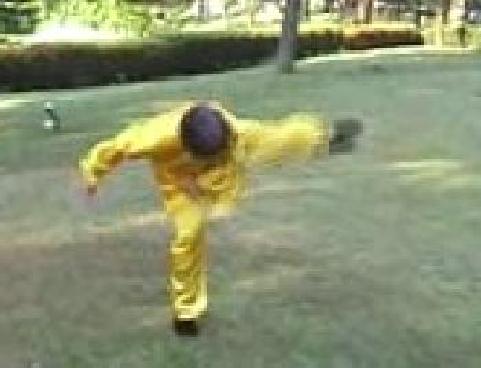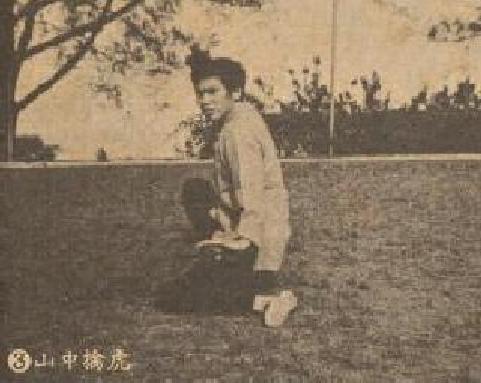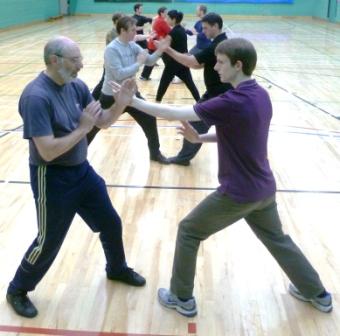December 2006 (Part 1)
SELECTION OF QUESTIONS AND ANSWERS

Grandmaster Wong demonstrating the famous but little understood Tiger-Tail Kick from the Tiger-Crane Set
Question 1
I have purchased two books written by Sifu Wong entitled “The Art of Chi Kung” and “Chi Kung For Health & Vitality”. Can I safely confirm that if I were to follow the instructions and techniques in the book I can also perform Chi Kung effectively?
— Lee, Malaysia
Answer
Yes, if you follow the instructions in my book correctly, you can perform chi kung (and not just gentle exercise) effectively. You can also derive very good results.
The key word is “correctly”. Of course everyone wants to practice correctly, but many do not follow my instructions correctly although they honestly think they are doing so.
Let me give you a simple yet very important example. My instructions state clearly that practitioners should stand upright and be relaxed. But many practitioners do not do so although they honestly think they stand upright and are relaxed. Nevertheless, if you follow my instructions respectfully, even though you may make some mistakes, you can still derive a lot of benefits.
Yet, the difference in benefits between learning from me personally and learning from my books is enormous. Many of my students first learned from my books. They found a lot of benefits. Then they reasoned to themselves that if they could get so many benefits by learning from my books, they should get more benefits learning from me personally. But they found the difference incomparable.
For example, if you practice for about half an hour a day, and are able to generate an energy flow inside yourself in six months, your result is remarkable, considering that many people may not have experienced any energy flow even though they have practiced daily for many years. But in my Intensive Chi Kung Course, participants experience energy flow within the first 15 minutes, and they are able to generate an energy flow on their own on the very first day of the course.
Why is energy flow so important in chi kung? It is because practicing chi kung is basically experiencing energy flow. In other words, if you do not experience any energy flow, you are not practicing chi kung, though you may perform chi kung forms. You are only practicing gentle exercise. Low level chi kung will need a long time of practice before there is some energy flow. High level chi kung produces powerful energy flow within a short time.
Chi kung promotes health, vitality and longevity because of energy flow. Life is a meaningful flow of energy. When his energy flow is harmonious, the person enjoys good health. When his energy flow is vigorous, he enjoys vitality. When his energy flow lasts for a long, long time, he enjoys longevity.
Question 2
I study the southern style of Shaolin Kung Fu, the Tiger Crane Combination, but I very rarely hear of it mentioned in martial art magazines or in films, internet, etc. I hope you could shed some light on its origins.
— Howard, England
Answer
The Tiger-Crane Combination is a famous set in Southern Shaolin Kungfu, especially in the style of Southern Shaolin widely known as Hoong Ka (Hung Gar). According to a popular legend, its origin was traced to Hoong Hei Khoon, the First Patriarch of Hoong Ka Kungfu, who specialized in the Black Tiger style of Southern Shaolin Kungfu learnt from the Venerable Chee Seen, the abbot of the southern Shaolin Monastery on Nine-Lotus Mountain in south China.
Hoong Hei Khoon's wife, Fong Wing Choon (also known as Fong Cheit Leong), was an expert of White Crane Kungfu, which is also a style of Southern Shaolin. Hoong Hei Khoon incorporated some White Crane techniques into his Black Tiger style, resulting in the famous “Tiger-Crane Double-Form Set”, or “Fu Hok Seong Yin Khuen” in Chinese (Cantonese). Their son, Hoong Man Ting, and disciple, Wu Ah Phiew, used the Tiger-Crane combination to kill the kungfu genius, Pak Mei, to avenge his leading role in the razing of the southern Shaolin Monastery.
The Tiger-Crane Set is a signature set in the Hoong Ka Kungfu from the lineage of Wong Fei Hoong, a famous master of recent times. The saying amongst kungfu circles that “In the north there is Hou Yun Jia, in the south there is Wong Fei Hoong” indicates not only the great kungfu skills of these two masters but also the great respect the public had for them. Hou Yun Jia defeated all foreign masters who went to China to test her kungfu, and founded the Chin Woo — meaning “essence of martial arts” — Association with branches in many countries. The modern movie “Fearless” is about him.
There are, however, some historical issues with this popular legend. The lineage of Wong Fei Hoong, who was well known for his tiger-claws and no-shadow kicks, was not directly from Hoong Hei Khoon, but from his junior classmate, Lok Ah Choy. Lok Ah Choy taught Wong Kai Ying, who in turn taught his son, Wong Fei Hoong. Nevertheless, this does not rule out the possibility that the Tiger-Crane Set was formulated by Hoong Hei Khoon, and later was transmitted to Wong Fei Hoong's lineage.
The second issue is that there are two other versions of the Tiger-Crane Set that are not traceable to Hoong Hei Khoon. And I have practiced all these three versions of the Tiger-Crane Set. The version from Wong Fei Hoong's lineage is long, composed of 108 patterns; the one I learned from Uncle Righteousness of Southern Shaolin Kungfu (later called “Hoong Ka” by my classmates) is short, composed of only 36 patterns; the one I learned from Sifu Choe Hoong Choy of Wing Choon Kungfu is of medium length, composed of 72 patterns.
A notable point is not the length of the set, but the patterns. There are actually more tiger and crane patterns in the 36-pattern set than in the 108-pattern set. Most of the patterns of the 108-pattern set are from Lohan Kungfu, which is the prototype of Shaolin Kungfu, whereas most of the patterns in the 36-pattern set are from Tiger-Crane. Many tiger and crane patterns of the 36-pattern set are not found in the 108-pattern set. Please see Similarites and Differences of Tiger-Crane Sets. But the principles and applications are the same. When one performs tiger or crane patterns from these two sets, it is difficult to tell their source. On the other hand, the 72-pattern set is quite different. The tiger and crane patterns here are “softer” (but not less effective). When patterns from this set are performed, an initiated observer can tell they are different from those of the other two sets.
The 36-pattern set is traceable to the Venerable Harng Yein, the senior classmate of Hoong Hei Khoon. The 72-pattern set is traceable to the famous Shaolin nun, Ng Mui, who was a senior classmate of Hoong Hei Khoon's teacher, Chee Seen. Thus, it was unlikely that these two Tiger-Crane sets were formulated by Hoong Hei Khoon, or derived from the one formulated by him.
Yet again, these issues do not necessarily rule out the possibility that the 108-pattern Tiger-Crane Set, which is now the most popular of the three versions, was formulated by Hoong Hei Khoon. It was possible that the two other sets were already in existence when Hoong Hei Khoon, inspired by his wife's kungfu and perhaps reminiscent of the tiger-crane combination he saw in his senior classmate's practice, incorporated the softer crane patterns from his wife's kungfu into his harder tiger style.
Question 3
I wonder why such an effective Shaolin style still seems to be so unknown compared to the Lohan and First Emperor styles?
Answer
Whether the Tiger-Crane Set is more or less widely known than Lohan Kungfu or First Emperor Kungfu is a matter of opinion. Those who practice Southern Shaolin would be more familiar with the Tiger-Crane Set, whereas those who practice Northern Shaolin are more familiar with Lohan Kungfu. In my opinion, First Emperor Kungfu is relatively less known.
The Tiger-Crane Set is actually a very well known set though few people today may understand its philosophy and able to apply its techniques for combat. A main reason is that the techniques in this set are highly sophisticated. Look at the pattern called “Catch a Tiger in the Mountain” for an example. Please see the picture below. Very few people may know, even in theory, how this pattern can be used for fighting, yet it is a very effective pattern for combat.
Kungfu masters normally do not wish to talk about the principles and applications of their kungfu. If they ever talk about kungfu, they usually only show their outward forms without demonstrating how these forms can be used in combat. On the other hand, those who only practice external kungfu forms — and they are the great majority of kungfu practitioners today — would be unable to demonstrate their application or explain their underlying principles even if they wished.
This is a main reason why today you can usually find only kungfu forms but not their applications or principles in the internet, videos and books. This is also a main reason why many kungfu practitioners turn to Karate and Kick-Boxing when they spar.
In this respect I am a “freak”. I have openly explained kungfu applications and principles in public. This is because we in Shaolin Wahnam do not want these wonderful arts to be lost.
You can find in Combat Sequences of Tiger-Crane Set, Miscellanoues Techniques of Tiger-Crane Set and Training Methods of Tiger-Claw detailed explanations of the principles and application of tiger-crane techniques as well as training methods of the tiger-claws that many masters would keep as secrets only for their advanced disciples.

An old photograph of about 30 years ago showing Grandmaster Wong demonstrating “Catch a Tiger in the Mountains”
Question 4
If the air is extremely cold or there is snow on the ground, would I be better off practicing Chi Kung inside (as I might be shivering outside and find it hard to concentrate)?
— Ben, Scotland
Answer
Yes, although it is generally better to practice outside, if the weather is unfavorable, such as when it is extremely cold, it is better to practice indoors.
But have good ventilation. Remember that in genuine chi kung, a practitioner takes in good energy and disposes of bad energy in his practice. If the ventilation is poor, one may take back his own bad energy.
If it is not feasible to open a window, have a fan blowing gently so that the air inside your practice room is moving. After your practice you may leave the room but open the windows to allow fresh air in for better circulation.
Question 5
Is it detrimental to practice Chi Kung indoors on a regular basis?
Answer
If you have poor ventilation all the time, it is detrimental to practice indoors on a regular basis. But if the ventilation is good, or if you at least open the windows after each practice session to let in fresh air and let out stale air, it can still be beneficial to practice indoors.
Question 6
In the park near where I live there are often drunk people at night, and my garden is shared so it is hard to go there and concentrate on my chi kung without disturbance. I have therefore been practicing in the park in the morning, and in my flat with windows open at night. (My room is beside a garden with trees and flowers.)
Answer
What you have done is correct. Unless one is already proficient in chi kung, it is inadvisable to have disturbances during practice. With drunk people around while your practice is certainly unwise. In such a situation and if you cannot get a suitable place, it is better to skip the practice session.
Practicing in your garden with trees and flowers is excellent.

As Taijiquan is an internal martial art, combat is an essential aspect. Pushing Hands is an excellent method to train combat skills.
Question 7
I took your New York course last year. Lately I have been practicing chi kung everyday and have been making progress. Before I had so many questions but after I have been practicing with Eugene, I can now answer those questions myself. But there is one question I would like to ask.
How can I become one of your disciples? I truly want to reach the highest levels of chi kung and kung fu but I know that wanting it is not enough.
— Peter, USA
Answer
I am glad that you are progressing in your practice, and have found answers to your many questions from direct experience.
Before one can become my disciple, he has to be a good student. Two fundamental requirements for being a good student is to practice the Ten Shaolin Laws and the chi kung and/or kungfu exercises as taught by the teacher. When the time is ripe you may progress to become a disciple.
Question 8
I am concerned with my loss of jing and loss of personal strength and confidence. I have recently been experiencing some intense stress and have literally reached the stage where I have no sexual desire at all and very little energy.
I hope that with Shaolin “chicken legs” training that I was taught I can slowly overcome this but I am deeply worried that it may not be possible for my strength and libido to be at all recovered. Honestly I do not know who else to speak to for assistance with this matter. I therefore humbly ask for any advice or assistance you may be able to provide.
— Chris, Australia
Answer
I am sorry to hear about your health problems, but the good news is that practicing high level chi kung can overcome them.
But you also need to know the following two important but little realized facts.
Because of various reasons, much of what is said to be chi kung today is actually not chi kung but gentle physical exercise. In other words, most practitioners all over the world, including in China today, practice what they honestly think is chi kung, but it is only gentle physical exercise. The forms they practice are genuine chi kung forms but they practice these chi kung forms not as chi kung but as gentle physical exercise.
The crucial difference between chi kung and gentle physical exercise is that in chi kung a practitioner works on energy, whereas in gentle physical exercise a practitioner works on his physical body like joints and muscles. If you do not know what working on energy is, it is unlikely you are practicing chi kung.
It is the same as in Tai Chi Chuan. Many people think that they practice Tai Chi Chuan, often shortened to Tai Chi, but actually what they practice is only gentle physical exercise performed in a dance-like manner. For convenience, we refer to this as Tai Chi dance.
The crucial difference between genuine, traditional Tai Chi Chuan and Tai Chi dance is that in Tai Chi Chuan a practitioner has internal force and is able to use his Tai Chi Chuan techniques for combat, whereas in Tai Chi dance a practitioner has no internal force and cannot use his dance-like techniques for combat. The Tai Chi Chuan practitioner practices an internal martial art, whereas the Tai Chi dance practitioner practices a dance-like physical exercise.
The second fact is that much of chi kung practiced today, even when it is genuine, is not of a high level. Many people may not like to hear this fact, but it is true. Low level chi kung may enable you to maintain some well being if you are already healthy, but may not be powerful enough to help you overcome your problems.
A crucial difference between high level chi kung and low level chi kung is that in high level chi kung a practitioner can generate a lot of energy flow within a shor time (like a few weeks), whereas in low level chi kung a practitioner takes a long time (like a few years) to generate a little energy flow.
I have not heard of Shaolin “chicken legs” training, but its name implies that it is not likely to be powerful enough for your purpose. I would recommend that you attend my Intensive Chi Kung Course in Malaysia where you can generate a lot of energy flow on the first day of the course itself. Alternatively you can learn from one of our certified Shaolin Wahnam instructors .
LINKS
Selected Reading
- Using Kungfu for Free Sparing is Certainly Possible
- In Search of Kungfu Secrets
- Crescent-Moon Spear with names of Patterns in Chinese
- Tan Tui or Spring Kicks — Part 2
- The Secrets of Sparring Methodology
